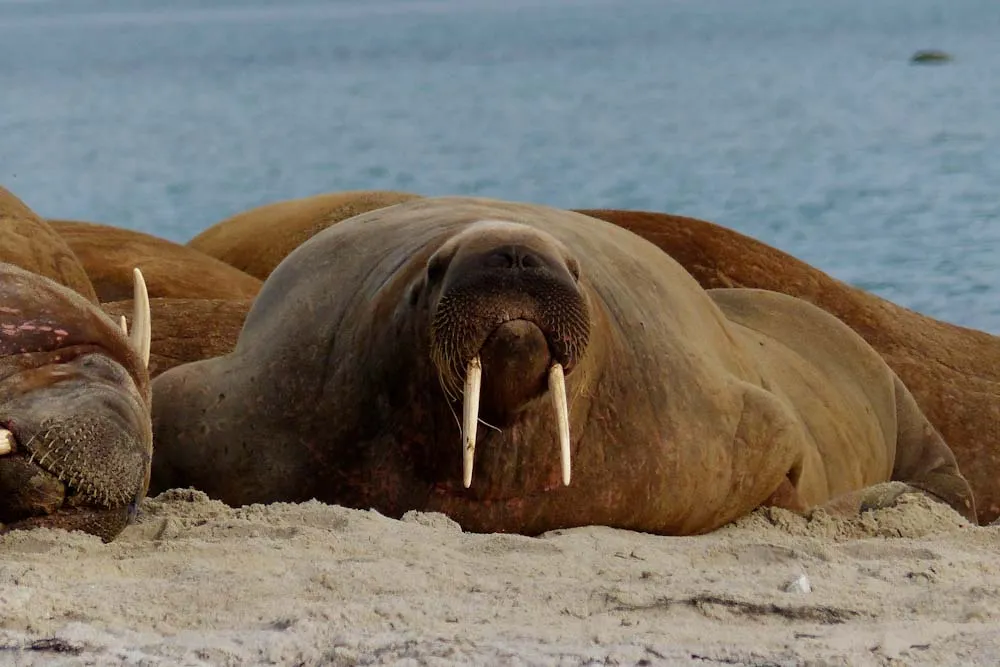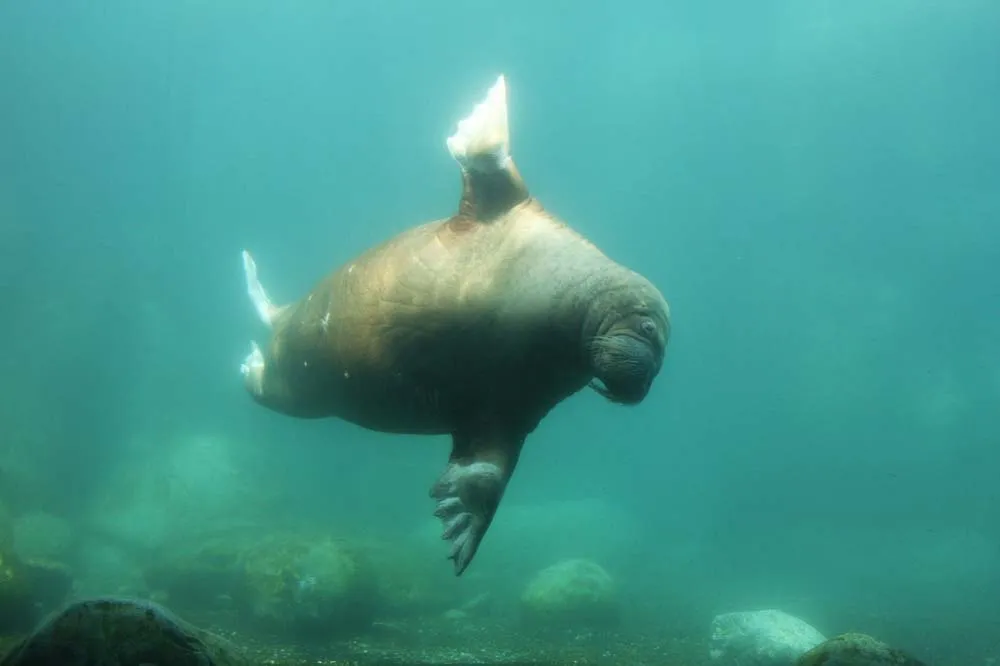Walrus are notorious for being tall and heavy marine mammals. Their body type, alongside their tusks, makes them impressive and iconic. Standing as the third-largest pinniped species, they are a force to be reckoned with.
An adult walrus typically weighs between 800kg and 1700kg and can reach lengths of 12 feet. Of the two subspecies, Pacific walruses are heavier and taller than Atlantic walruses and males are much heavier than females. All walruses are born at relatively the same large size.
How do males and females compare and how does this compare to humans? Keep reading to find out or check out our full list of 16 interesting facts about walruses to learn more about these iconic marine mammals.
How Much Do Walruses Weigh?
Generally speaking, the size and weight of a walrus depends upon the gender and which sub-species it belongs too. Adult male walruses are heavier than adult females, whilst Pacific walruses are generally heavier than Atlantic walruses1 (source: F.H. Fay “Odobenus rosmarus”. Mammalian Species. Vol. 238, pp.1–7. 1985).
Adult male Pacific walruses weigh between 800 and 1,700 kg (1,800 and 3700 lb) on average2 (source: G.L. Wood, The Guinness book of animal facts and feats, 1986). Adult female Pacific walruses weigh less than males, at an average of 800 kg (1,800 lb)3 (source: University of Michigan).
As for the other subspecies, adult male Atlantic walruses are typically 10-20% lighter than their Pacific walrus counterparts4 (source: F.H. Fay “Odobenus rosmarus”. Mammalian Species. Vol. 238, pp.1–7. 1985). Male Atlantic walruses weigh an average of 900 kg (2,000 lb) compared to females which weigh an average of 560 kg (1,230 lb)5 (source: University of Michigan).
Why Are Walruses So Fat?
Walruses are fat so they can stay warm and survive the cold temperature of the arctic and sub-arctic regions where they live.
Walruses store most of their body fat as blubber, which is a thick layer just below their skin. This blubber is reinforced by fibrous connective tissue, and also functions as an energy reserve.
Having this thick layer of fat allows them to maintain their core body temperature at around 36.6°C (97.9°F). Remember, walruses are mammals which means that they are warm-blooded.
Generally speaking, a walrus’s blubber accounts for up to one-third of its total body mass – this is particularly seen during winter months6 (source: Wikipedia).

How Big is a Walrus?
Walruses are very big marine mammals. As with weight, the size depends on the gender and sub-species. Pacific walruses are slightly larger than Atlantic walruses and adult males are larger than adult females of the same sub-species.
An adult male Pacific walrus reaches 2.7 to 3.6 m (9-12 ft), compared to adult females that reach 2.3 to 3.1 m (7.5-10 ft).
Meanwhile, an adult male Atlantic walrus reaches 2.4 m (8 ft)7 (source: Seaworld).
How Big is a Walrus Compared To A Human?
Walruses are much bigger than humans. However, walrus and humans are similar in the sense that males are generally bigger than females8 (source: Health Line).
Walruses are much heavier than humans. The average adult male human in the US weighs around 90 kg (198 lb) whereas an adult male Pacific walrus weights 800 – 1700kg (1,800 – 3700 lbs). This means that walruses can be around 19 times heavier than humans.
Walruses are also much larger than humans in size. The average height of an adult male human in the US is around 161.8 cm (5 ft 9 in) whereas an adult male Pacific walrus reaches 2.7 to 3.6 m (9-12 ft). If an average male human were to lie next to a Pacific walrus, it would be around twice as long.
How Big is the Biggest Walrus?
The biggest walruses tend to be adult males from the Pacific subspecies. There is some contention about the largest ever walrus.
Two recordings of male walruses from 1909 and 1910 put the specimens at around 2,300 kg (5,000 lb). However, these body mass calculations were taken using only the hide (the skin of the animal) and then estimating the total weight on the basis that the hide is typically 20% of its total weight9 (source: University of Michigan).
Odin holds the record as the largest living walrus at around 1700kg (3,700lbs). He is a captive walrus, originally from a zoo in Moscow and now living at a zoo in Germany10 (source: Daily Mail).
How Big is a Baby Walrus?
As you might expect, baby walruses are quite large when compared to other mammals. An average newborn walrus typically weighs from 33 to 85 kg (73 to 187 lb).
In contrast to the weight of adult walruses, there is no significant difference in the weight of the walrus calves between the two subspecies11 (sources: IUCN and University of Michigan).
The size of a baby walrus is typically between 1 to 1.4 m (3ft 3 inch to 4ft 7 in)12 (source: IUCN).
For Pacific walruses, males and females sexually mature at different rates. Female walruses mature at 6-7 years old, whereas it takes 8-10 years for adult males to mature. After 15 months of gestation, it takes a walrus calf around two years to become independent. When walruses do become independent, they typically weigh around 240kg (750 lbs)13 (source: Alaska Department for Fish and Game).
How Do Walruses Move?
Being such large animals, you may wonder how walruses can move around. Well, they have limbs that have evolved into flippers. These flippers are adapted to facilitate walrus movement both in and out of the water.
Whilst in water, their hind flippers propel them forward, allowing them to reach speeds of up to 35km/h (22mph). Whilst on land, they can rotate their flippers to allow them to walk on all fours on the sea ice or landmass.

How Strong Are Walruses?
Walruses are perceived to be very strong because of their heavy weight, tall height, and large tusks14 (source: Seaworld). They are also strong enough to impale their natural predator – polar bears – if the conflict is necessary.
Another example of the strength of the walrus is how they can capsize vessels15 (source: The Polar Bear Programme).
Walrus bones are also much stronger than seal bones16 (source: E. Hill, Études Inuit Studies, Vol. 41(1-2), pp.73–99. 2017). This has possible links to the trade of walrus bones.
Related Questions
How Big Are Walrus Tusks?
Walrus tusks can be more than 90 cm (35.3 in) long. Although adult male walrus tusks tend to be longer and straighter, adult female tusks can grow to 80 cm (31.4 in)17 (source: National Geographic).
Also, as particularly seen in Pacific walruses, adult males have heavier tusks on average than females18 (source: F.H. Fay, North American Fauna, Vol. 74, No. 74, pp.1–279, 1982). A singular adult male walrus tusk can weigh up to 4 kg19 (source: R.A. Kastelein, Encyclopedia of Marine Mammals (2nd ed), pp.1212-1217, 2009).
How Big is a Walrus Brain?
A walrus brain has been measured to weigh between 1.02 and 1.126 kg. This is slightly lighter than an adult human brain which is between 1.3 and 1.4 kg20 (source: Washington University).
How Big is a Walrus Weiner?
Male walruses have a baculum, this is a bone found in the penis of some mammals. Walruses have a baculum that can reach around 55cm (22 in)21 (source: L. Bartosiewicz, International Journal of Osteoarchaeology. Vol. 10, 2000).
How Old Can Walruses Live?
Walruses can live up to 40 years old22 (source: Alaska Department for Fish and Game).


![You are currently viewing How Big Are Walruses? [Size + Weight Compared to Humans]](https://polarguidebook.com/wp-content/uploads/2022/09/Walrus-Size.jpg)


